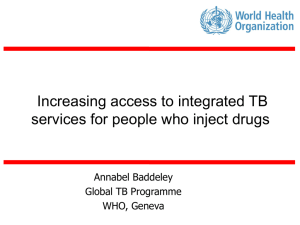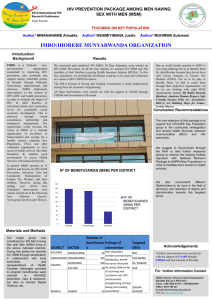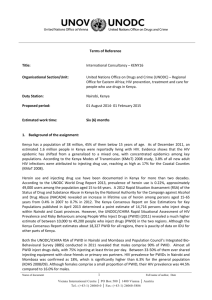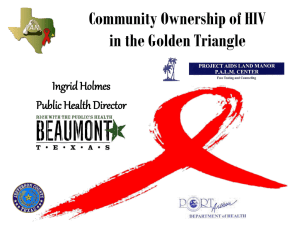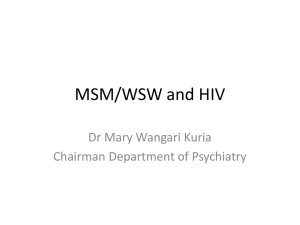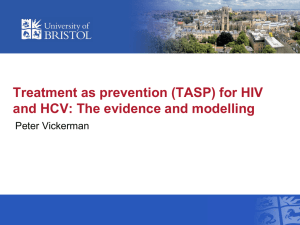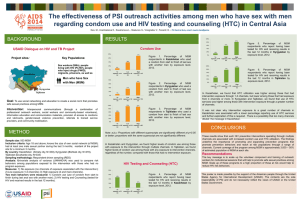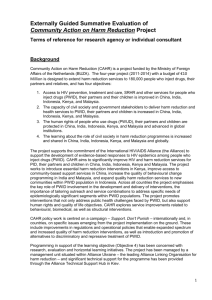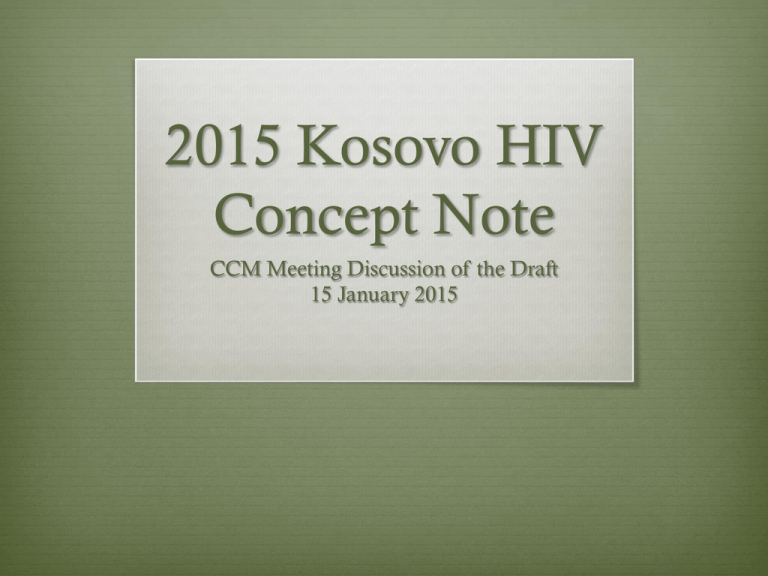
2015 Kosovo HIV
Concept Note
CCM Meeting Discussion of the Draft
15 January 2015
Key Assumptions/Requirements
Same level of funding for 2.5 years;
Little likelihood of additional future funding;
Government to take over: contribution from
40% to full coverage;
Focus on key affected populations;
Address low coverage, treatment interruptions,
MMT dropouts, and lack of behavioural
changes
Highlights
Main allocation and above
allocation
Counterpart financing and
Willingness to pay
Online grant management platform,
credentials, CCM endorsement
Process and Challenges
Changes in the Government and strategic
planning processes;
KP’s representation weak; no
networks/associations;
Key population estimates, IBBS in 3 sites,
extrapolation problematic, implications of
overestimating, more size estimates required;
Coverage increase – new outreach strategies,
adjusted service combinations
Population size estimates: PWID
City
population
Municipality
population Adult
2012
population
Total population Adult population
IBBS Size drug use
drug use
Estimate prevalence
prevalence
Medium
Prizren
prevalence prevalence
extrapolation extrapolation
1Pristina
145149
205133
157952
3946
1.923630035
2.498220825
3946
3946
2Prizren
85119
181756
139952
1113
0.612359427
0.795271983
1113
1113
3Gjilan
54239
91413
70388
1159
560
4Peja
48962
98237
75642
1246
602
5Mitrovica
46230
73160
56333
928
448
6Ferizaj
42628
111141
85579
1409
681
7Gjakova
40827
96071
73975
1218
588
8Vushtrri
27272
71042
54702
901
435
9Podueva
23453
89185
68672
1131
546
513879
1815606
783196
13051
8918
Total
Goal:
Maintaining the low prevalence
of HIV and improving the quality
of life of affected people through
the improved cascade of HIV
prevention and care services
Target Populations
PLHIV
PWID
FSW
MSM
Prisoners
Migrants
Vulnerable women and girls
Vulnerable ethnic minorities (RAE)
Objectives and modules
Ob1: To improve access of KPs to quality
HIV prevention and care (Mod.1-4)
Expand coverage:
Mobile service delivery;
Local peer educators;
Peer driven interventions;
Secondary service delivery
Service quality???:
High quality verbal BCC;
In-depth understanding of risk factors;
Risk management measures (PSCM);
Patient monitoring and treatment quality control
Ob2: To improve detection of HIV and facilitated
access to care and treatment (Mod. 1-5)
Promotion/availability of HTC for KAP;
Promotion of HTC of pregnant women;
Strengthening continuum of prevention/care services:
linking HTC to prevention, care and treatment
(regulations and referral mechanisms);
Improved retention through patient associations
and community quality monitoring;
laboratory capacity to monitor the treatment
effectiveness;
promote the development and rollout of treatment
protocols
Ob3: To create supportive environment for
sustainable HIV/AIDS response (Mod. 6-8)
Policy development and advocacy function
(PAG);
Strengthening essential community systems
(associations and networks) to address stigma
and discrimination, monitor/ensure quality;
Client registration and service monitoring
software, bio-behavioural monitoring, KP size
estimates, formative studies;
HIV Prevention
Service model
Needles and syringes (PWID)
Condoms (all KPs)
Information (all KPs)
Unknown status
HIV+
HIV-
HIV testing (up to
40%)
TB screening
HCV testing
HBV testing
1 mobile clinic
STI testing
PDI Partners
recruitment
and education
Counseling
Social support
Legal support
Psychological
OST (MMT)
Community Based
Organisation
referral
OST (MMT)
ART Treatment
Treatment for HIV
Treatment for TB
Treatment for STI
HBV vaccination
Health facility
Mod. 1. Prevention for PWID and their
partners
Outreach strategies (staff, mobile, PDI, secondary);
Adequate number of needles;
Adequate types of needles;
Alcohol swabs and sterile water?;
Strengthened BCC procedures;
Better detection of HIV and linkages to care and
treatment;
Limited room for complementary services (legal aid).
Mod.2-4. MSM, FSW, Other
Outreach strategies: peer workers etc. (all);
Condoms and lubricants (condoms for all);
Strengthened BCC (all);
Gynaecological and STI services (SW);
HIV (all), HBV, HCV testing;
Prison personnel: study visit
Women and RAE: IEC materials and group education sessions;
Migrants, Women and RAE: Testing during events;
Mod.5. Treatment, care
and support
Community-based care and support
Monitoring of treatment effectiveness
Community monitoring of treatment quality
Mod.6. HSS: Procurement and
supply chain management (PSCM)
Closer collaboration between stakeholders
Risk management strategy
International TA
Good storage practice workshop
Mod.7. HSS: Health information
systems and M&E
Improved service monitoring;
Monitoring of drug scene and contextual factors to adjust interventions:
Operational studies (Prison NSP, RAE vulnerabilities)
Reports by frontline service providers
Assess the need of NSP in prisons
Feasibility of introduction of Low Dead Space (LDS) syringes
Preferred types of injecting instruments to inform procurement;
Consultations with prison health workers on situation changes;
Analysis and solutions for Naloxone;
KP size estimates (nationwide or in a selection).
Module 8. Removing legal barriers to access
PAG (including a legal analyst)
Legislation analysis and promotion of improvements (EU accession
commitments, antidiscrimination legislation, legislation conflicts)
E.g. trafficking of humans and transactional sex – to standard practice of law
enforcement officers etc.;
Policies and procedures to ensure the required level of service uptake and
retention;
Development of community systems and community involvement in service
monitoring and quality assurance;
Codes of professional practice and ToR;
Operations, routes and schedules of service delivery units (mobile unit);
Development of CBOs, including PLHIV networks and peer-support groups;
Prison programme advisory council;
BCC module related to OD;
Improved detection of HIV (pregnant women and symptomatic patients) policies and procedures
Impact and outcome targets
Indicator
2014
IBBS
2017
target
% SW living with HIV
0%
<5%
% MSM living with HIV
2.3%
<5%
% PWID living with HIV
0%
<5%
% PWID who used sterile syringe
during last injection
2011
base
2014
target
99%
80%
82%
85%
% MSM who used condom during last 53%
anal sex
85%
66%
85%
% SW who used condom with latest
client
85%
62%
85%
43%
Coverage targets: PWID
Population size: 8918 in 9 municipalities
Essential services: 2134/3400/4500/5350
VCT: 719/1360/1800/2140
Needles/person: 10/100/100/100
MMT: 94/150/200/250 (Increase if clients of public
facilities are included)
Coverage targets: MSM
Pop size: 13432
Basis services: 1533/1600/3000/5373
VCT: 182 (2013)/640/1200/2149
Coverage targets: FSW
Denominator: 4586
Basic services: 272 (2013)/1000/1500/1900
VCT: 272 (2013)/400/600/760
Other populations
Prisoners: 1380 (100%)
VCT: 552 (40%)
Women and girls: 9008/13512/13512
RAE: 5335/8002/8002
PLHIV care and support: 28/35/40/45
Budget Summary (Allocation)
Module
Prevention programs for people
who inject drugs (PWID)
Y1
Y2
Y3
Total
%
172 865
317 651
387 994
878 510
34%
Prevention programs for MSM
Prevention programs for sex
workers and their clients
Prevention programs for other
vulnerable populations
88 658
149 432
196 018
434 108
17%
56 411
84 576
89 724
230 711
9%
39 105
79 950
74 193
193 249
8%
Treatment, care and support
HSS: Procurement and supply
chain management (PSCM)
HSS: Health information
systems and M&E
Removing legal barriers to
access
122 555
45 509
45 909
213 973
8%
5 036
0
0
5 036
0%
16 325
47 923
35 771
100 019
4%
7 010
15 268
13 520
35 798
1%
98 451
187 902
187 902
474 256
18%
606 415
928 211
1 031 032
2 565 658
100%
Program management
Total
Budget Summary (Above)
Module
Prevention programs for people
who inject drugs (PWID)
Y1
Y2
Y3
Total
%
44 411
64 572
72 587
181 571
37%
Prevention programs for MSM
Prevention programs for sex
workers and their clients
Prevention programs for other
vulnerable populations
12 271
9 224
11 345
32 841
7%
31 662
36 635
45 875
114 172
23%
9 682
9 802
9 802
29 286
6%
Treatment, care and support
HSS: Procurement and supply
chain management (PSCM)
HSS: Health information
systems and M&E
Removing legal barriers to
access
32 928
0
0
32 928
7%
0
0
0
0
0%
10 355
68 241
17 886
96 481
20%
500
500
500
1 500
0%
0
0
0
0
0%
141 809
188 974
157 995
488 778
100%
Program management
Total
Thank you and
good luck!

